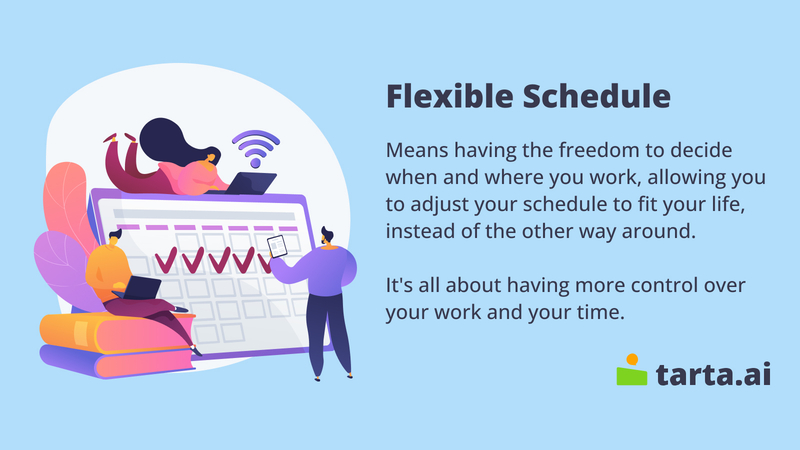From 9 to 5 to Flexible Work Arrangements: The Changing Face of the Modern Workplace
Flexible work arrangements refer to alternative work schedules that allow employees to have more control over when, where, and how they work. These arrangements are becoming increasingly popular in the modern workplace, as employers seek to attract and retain top talent, and employees demand more flexibility to balance work and personal responsibilities.
Traditionally, work has been structured around the 9 to 5 schedule, with employees expected to work a set number of hours in a physical office location. However, this model is no longer practical or desirable for many workers, particularly in light of the ongoing COVID-19 pandemic.

As we move further into the 21st century, the need for more flexible work arrangements is becoming increasingly apparent. In this article, we will explore the history of traditional 9 to 5 work arrangements, the benefits of flexible work arrangements, and the need for change in the modern workplace.
The Benefits of Flexible Work Arrangements
Flexible work arrangements offer numerous benefits for both employees and employers. Here are some of the key advantages:
- Improved work-life balance: One of the main advantages of flexible work arrangements is that they allow employees to better balance their work and personal lives. This can lead to lower levels of stress and higher levels of job satisfaction.
- Increased employee productivity and motivation: Studies have shown that employees who have more control over their schedules and work arrangements tend to be more productive and motivated. When employees are able to work during their most productive hours or from a location that suits them best, they are more likely to be engaged and focused on their work.
- Reduced stress and burnout: Traditional 9 to 5 work arrangements can be stressful and exhausting, leading to burnout and poor mental health. Flexible work arrangements can reduce these negative effects by allowing employees to take breaks or work from home when needed.
- Cost savings for both employees and employers: Flexible work arrangements can save both employees and employers money. Employees can save on commuting costs and may also have more flexibility to manage childcare or eldercare responsibilities. Employers can save on office space and other expenses related to maintaining a physical workspace.
- Increased flexibility for scheduling and location: Flexible work arrangements allow employees to work from anywhere, at any time. This can be particularly beneficial for employees who have to juggle multiple responsibilities or who live far away from their workplace.
Interesting fact:
According to a study by Global Workplace Analytics, remote work has grown by 140% since 2005.
Overall, the benefits of flexible work arrangements are clear. By offering more control and flexibility to employees, employers can improve productivity, reduce turnover, and create a more positive and supportive work environment.
Types of Flexible Work Arrangements
There are various types of flexible work arrangements that employers can offer to their employees. Here are some of the most common types:
- Remote work: Remote work allows employees to work from home or from another location outside of the traditional office environment. This can provide employees with more flexibility and autonomy over their work schedules.
- Flextime: Flextime allows employees to have more control over their work schedules, such as by adjusting their start and end times or taking time off during the workday for personal reasons.
- Compressed workweeks: Compressed workweeks allow employees to work longer hours over fewer days, such as working four 10-hour days instead of five 8-hour days.
- Job sharing: Job sharing allows two employees to share one full-time job, splitting the responsibilities and work hours between them.
- Part-time work: Part-time work involves working less than a full-time schedule, such as working three days a week instead of five.
- Freelancing and contract work: Freelancing and contract work involve working on a project-by-project basis, typically as an independent contractor rather than as an employee.
These flexible work arrangements can be combined or customized to suit the needs of individual employees or teams. By offering a range of options, employers can create a more inclusive and accommodating workplace culture.
Interesting fact:
The implementation of flexible work arrangements can save employers up to $11,000 per year per employee in real estate, electricity, and other expenses.
The Challenges of Implementing Flexible Work Arrangements
While flexible work arrangements offer many benefits, implementing them in the workplace can also pose challenges. Here are some of the main challenges that employers may face:
- Resistance to change: Some employees may be resistant to the idea of flexible work arrangements, particularly if they are used to traditional 9 to 5 schedules or are concerned about the impact on their workload or job security.
- The need for clear communication and guidelines: To ensure that flexible work arrangements are successful, employers need to provide clear guidelines and expectations around how they will work. This can help to avoid confusion or miscommunication and ensure that all employees understand what is expected of them.
- The potential for decreased face-to-face interaction and collaboration: Flexible work arrangements can sometimes result in less face-to-face interaction and collaboration between employees, which can have an impact on team cohesion and productivity.
- The need for effective technology and communication tools: Flexible work arrangements require effective technology and communication tools to ensure that employees can work together and stay connected regardless of their location. Employers need to invest in the right tools and infrastructure to support remote work and collaboration.
- Ensuring fair and equal treatment for all employees: Employers need to ensure that all employees, regardless of their work arrangement, are treated fairly and have access to the same opportunities and benefits. This includes ensuring that employees who work remotely or part-time are not disadvantaged in terms of career advancement or compensation.
By recognizing these challenges and taking steps to address them, employers can successfully implement flexible work arrangements and create a more productive and supportive workplace culture.
The Future of Work: The Importance of Flexible Work Arrangements
Flexible work arrangements are becoming increasingly important in the modern workplace, and there are several reasons why they are likely to continue to grow in importance.
The pandemic has accelerated the adoption of remote work and other flexible work arrangements, as many companies were forced to shift to remote work in response to lockdowns and social distancing requirements. This has demonstrated the viability and benefits of flexible work arrangements, and is likely to lead to a more permanent shift towards remote and flexible work.
Younger generations of workers are increasingly seeking out flexible work arrangements that allow them to achieve a better work-life balance and greater autonomy over their work. Employers that fail to offer flexible work arrangements may struggle to attract and retain younger workers.
Advances in technology are making it easier for employees to work remotely and collaborate effectively, regardless of their location. As technology continues to evolve, it is likely that remote work and other flexible work arrangements will become even more prevalent.
Interesting fact:
A survey by FlexJobs found that 80% of millennials say they would be more loyal to their employer if they had flexible work options.
Flexible work arrangements can help to create a more diverse and inclusive workplace culture, as they can accommodate the needs of employees with different backgrounds, abilities, and preferences. This can help to improve overall employee satisfaction and productivity.
To ensure that flexible work arrangements continue to be successful, employers need to regularly evaluate and adapt their policies and practices. This may involve soliciting feedback from employees, monitoring the impact on productivity and other key metrics, and making changes as necessary.
As the workplace continues to evolve, flexible work arrangements are likely to become increasingly important for both employers and employees. By embracing and adapting to these changes, employers can create a more productive and supportive workplace culture, while also attracting and retaining top talent.

Photo: Annie Spratt/Unsplash
In conclusion, flexible work arrangements offer many benefits for both employees and employers, including improved work-life balance, increased productivity, reduced stress and cost savings. However, implementing these arrangements can also pose challenges, including resistance to change, decreased face-to-face interaction, and the need for effective communication and guidelines.
As the workplace continues to evolve, it is important for employers to adapt to the changing needs and expectations of the modern workforce. This includes embracing flexible work arrangements, investing in the right technology and communication tools, and ensuring fair and equal treatment for all employees.
Looking to the future, the importance of flexible work arrangements is likely to continue to grow, driven by factors such as the impact of the COVID-19 pandemic, changing expectations of younger workers, and advances in technology. By embracing these changes and continuing to innovate and adapt, employers can create a more productive, inclusive, and supportive workplace culture that benefits both employees and the bottom line.
- Flexible work arrangements offer numerous benefits, including improved work-life balance, increased productivity, reduced stress, and cost savings.
- Different types of flexible work arrangements include remote work, flextime, compressed workweeks, job sharing, part-time work, and freelancing.
- Implementing flexible work arrangements can pose challenges, including resistance to change, decreased face-to-face interaction, and the need for effective communication and guidelines.
- Adapting to the changing needs and expectations of the modern workforce, investing in technology and communication tools, and ensuring fair and equal treatment for all employees are crucial in implementing flexible work arrangements.
- The future of work is likely to continue to evolve, driven by factors such as the impact of the COVID-19 pandemic, changing expectations of younger workers, and advances in technology. Employers need to embrace these changes and continue to innovate and adapt to create a more productive, inclusive, and supportive workplace culture.
FAQ
What are some common types of flexible work arrangements?
Some common types of flexible work arrangements include remote work, flextime, compressed workweeks, job sharing, part-time work, and freelancing.
What are the benefits of flexible work arrangements?
Flexible work arrangements offer numerous benefits, including improved work-life balance, increased productivity, reduced stress, and cost savings for both employees and employers.
What are some challenges of implementing flexible work arrangements?
Some challenges of implementing flexible work arrangements include resistance to change, decreased face-to-face interaction, and the need for effective communication and guidelines.
What is the future of work in relation to flexible work arrangements?
The future of work is likely to continue to evolve, driven by factors such as the impact of the COVID-19 pandemic, changing expectations of younger workers, and advances in technology. Employers need to embrace these changes and continue to innovate and adapt to create a more productive, inclusive, and supportive workplace culture.